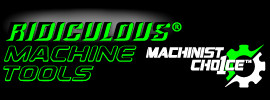How to Install a New Drill Chuck on a Drill Press
Posted by RMT on Feb 3rd 2023
Installing a drill chuck on a drill press doesn't have to be complicated if you are mindful of the few essential steps. If done correctly, your chuck will remain secure and accurate for the foreseeable future without needing frequent adjustments.
Drill presses and many other machine tools use Morse tapers to allow users to attach a wide variety of accessories to the machine via an arbor. The arbor has a Morse taper to fit the machine and an opposing taper to fit the accessory. For a drill chuck, this opposing taper is typically a Jacobs taper. It is very important to buy an accurate arbor that you can trust; Ridiculous Machine Tools offers excellent Arbors and Drill Chucks at the best price in the industry.
Fitting a male arbor taper into a matching female taper produces interference-fit joints that are very tight and accurate. Once their contact surfaces are brought into intimate contact, they will lock as long as their surfaces are burr-free and clean. Since these tapers are ground to a high degree of precision, they are also self-aligning. When installed correctly, the arbor will go in straight and stay there unless someone beats it out of alignment with multiple blows from a hammer during or after installation.
To install an arbor:
1. Use a clean, dry cloth to wipe down the arbor and socket. Refrain from using any solvents at this time, as we don't want them to be locked yet.
2. Inspect the socket and arbor and completely remove any burrs found. Note that even new chucks and arbors can have burrs, so don't assume it's okay just because it is new.
If you gently spin the arbor in the socket, any burrs will usually produce a bright line that is clearly visible. If the bright line is on the arbor, then the burr is on the chuck taper, and vice versa. Work on that burr until it is gone.
To ensure a good fit, it is crucial to make sure that the defects on the taper are not visible after smoothing. As long as the rest of the taper remains in its original form, smothering any burrs should be sufficient.
3. After the burrs have been removed, use OOO steel wool or a Scotchbrite pad to clean the taper and arbor. This will make sure that any dirt or oxidation is also taken off; this step should be done with new arbors and chucks too.
4. To ensure a proper fit, it is important to thoroughly clean the arbor and socket surfaces with a lint-free rag soaked in lacquer thinner or acetone. Do not touch these areas with your hands afterwards. Note that rubbing alcohol may contain oil which could prevent a secure fit of the tapers.
5. To secure the chuck firmly to a surface, retract the jaws into the body and place it on a clean, flat surface such as an anvil or level concrete. To prevent any damage to the nose of the chuck, lay down a sheet of paper first. Avoid placing it directly on timber workbenches.
6. To secure an arbor in a chuck, insert the male end into the socket. To get it to align properly, give it a slight twist as you move it inward. Try to push the arbor in straight to avoid any cocking – this will guarantee a good fit.
7. Place a wooden block at the end of the arbor, then use a steel hammer to give it a single firm tap downwards. Refrain from using an over-forceful strike - just one firm tap is all you need. When mounting a chuck to an unyielding surface, a gentle tap should be sufficient to secure the arbor. Avoid striking it multiple times as this could damage the arbor and socket, which should have been cleaned beforehand for optimal performance. The arbor will remain stable until you physically take it out and you can guarantee alignment accuracy.
Before you fit the chuck into the drill press, make sure to shift the table away from your workspace for extra safety. To insert the chuck and arbor into the socket, slide them in while keeping the jaws retracted. To ensure protection of the nose of the chuck, cover it with a piece of wood before delivering a single hard strike to its nose.
Your chuck is now installed and should remain there until you need to remove it. When you do need to remove it, it will come out easily. Now, let's go make some holes.


